To start the treatment of onychomycosis on time, you need to know what the nail fungus looks like.Mushrooms associated with dermatophytes, candidates and yeast -like species can provoke the disease.Timely and proper determination of the pathogen will allow you to quickly and effectively cure the fungus on your feet.
What is a nail sponge?
The fungal nail disease has a scientific name - onychomycosis, which from ancient Greek means "chronic infection".This disease affects the nail plate, in which the force has been broken for some reason.Fungus disputes are rapidly spreading, they do not need special conditions for development.The disease itself does not occur due to the high survival of the fungi.
Causes of nail fungus
Factors as a result of which the nail fungus manifests itself:
- Wet and warm environment.After a long day spent in shoes, the legs sweat a lot.You need to dry your shoes and completely abandon synthetic socks.
- Age.The largest number of cases of the disease occurs between the ages of 18 to 55 years.Generally, men suffer.If in young people nail fungus is extremely rare, then in men of adult age, the rate of frequency of at least 90%.This is mainly due to the decreasing nail growth.
- Medicines.Taking drugs such as antibiotics and cytostatics can cause the disease.
- The immune system.Once you have stepped with unprotected legs on any dirty surface, you can easily get infected.A person with weak immunity to do this is much easier.
- Profession.Nail fungus can occur due to high temperature in the work hall, seal or ionizing radiation.Employees of mini, medical institutions, baths and showers are most susceptible to the disease.
Three main paths were identified through which the fungus was able to fall under the toenails:
- Through the nail roll.The nail roll is a folding of the skin surrounding the nail plate on 3 sides.
- Through the edge of the nail.In this case, the fungus enters the nail, not on it.In the future, this can become keratosis, a disease during which the nail begins to separate from the nails.
- Through the dorsal nail.This part is the most durable, which is why the fungus penetrates much more frequently.
Nail fungus
What does the nail fungus look like depends on which particular type of fungus has provoked the disease
Dermatophytes
This is the most common type of fungal disease.Dermatophyte nails are affected in 90% of cases.
There are 3 varieties of this disease, each has different territory of the lesion:
| Trichophyte rublerum | Affecting the nails and legs |
| Epidermophyte | The fungus manifests themselves in 1st and 5th finger |
| Trichophyte | The fungus is manifested in 1st and 5th finger can go in interdigital folds |
Forms
This type of disease is extremely rare.When infected, the nail plate changes color and turns black, yellow, brown or blue.
Yeast -like mushrooms
These mushrooms are able to manifest not only the nails, but also the cause of the thrush in girls.The disease makes the nails sweeter.The nails acquire yellow.If the disease is ignored, then it is possible to separate the nail from the box.
Stages of the disease

What the nail fungus looks like depends on the stage of the disease.
In medicine, it is customary to distinguish 3 main stages of its development:
- In the first stage, it is quite difficult to identify the presence of fungi.Everything because there are no visible signs.
- The second stage.When they move to the second stage, the nails lose their luster, the color of the plate gradually begins to change.The nail becomes broad at the ends.You can now see small white spots or channels that will increase in size over time.
- The third stage is a neglected form of pathology when one ignores the disease for a long time and does not cure it.At that time, there was a huge risk of losing the nail.It begins to wide and break more and more.
What does nail fungus look like: symptoms and signs
The fungus has severe symptoms.At the onset of the disease, the gloss on the nail gradually disappears.The surface of the slab becomes a wave -like wave, small white spots appear.
Over time, the nail becomes brittle, flaky.Despite its fragility, the thickness of the nail can increase.Perhaps an unbearable feeling of itching between the fingers.Sleeping in the legs gradually increases.Probably the appearance of calluses and bubbles.
Another different sign of the disease is an unpleasant odor.This is due to the fact that the gap between the nail and the bed is clogged with dirt and the products of the fungi.
When the disease is significantly fired, the patient may increase the fever and pain in the legs, which prevents him from moving normally.
Regional onychomycosis
Regional onychomycosis is the original stage of the disease.At this stage, it is quite difficult to determine the disease.
What the nail fungus looks like depends on the degree of development of the pathology.Narrow gray lines gradually appear along the edges of the plate.The nail itself begins to dumb.In the center of the nail, yellow spots of small size appear.The plaque does not change the thickness, but it becomes fragile.
The nail is not completely affected.Only his individual sections suffer.Therefore, the surface of the affected nail becomes checkered.You can think of the gray substance under your nails, but the nail itself does not get more than it.
Normal
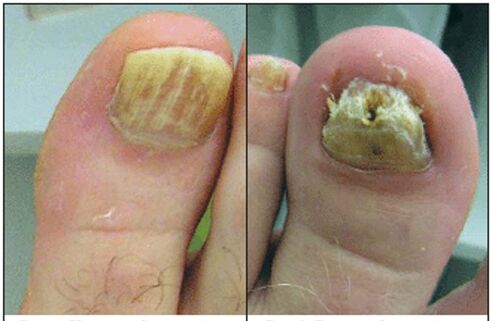
Normotrophic onychomycosis occurs for the same reasons as the other fungi.The microorganisms enter the skin, after which they penetrate from its surface through small damage deep into the nails.
With normotrophic onychomycosis during the first days of the disease, the color of the nail does not change completely, but only in areas.On the side and finally the nail turns white, yellow or gray.The nails lose its luster and fades.Over time, the color of the nail changes completely, but its thickness does not diminish.
Hypertrophic
Hypertrophic onychomycosis is considered an advanced form of normotrophic type of disease.The reasons for its appearance do not differ from the causes of other types of nail fungus.
The onset of hypertrophic onychomycosis contributes to contact with infected people wearing uncomfortable shoes or hygiene disorders.The cause may also be diseases: HIV, hyperhidrosis and diabetes.
The feet with hypertrophic onychomycosis The thickness of the nail increases significantly.The thickening of the plate can lead to a disease such as hyperkeratosis (in the disease of the skin under the nail becomes keratinized).
The color of the plate changes, which is why it looks yellow or gray.The nails become opaque, dumb.The appearance of onychgrifosis is possible - a fungus in which the nail is deformed and takes the shape of a bird's nail.
With hypertrophic onychomycosis, the lateral parts of the nail suffer the most.As a result, severe pain in the fingers occurs, allowing a person to move normally.
White surface
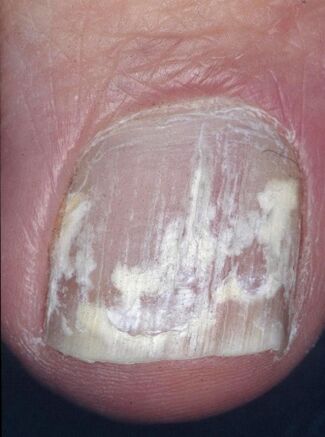
The white superficial form of onychomycosis is the most common type of disease.It damages the nail of the thumb and the little finger.
In the disease, the nail leg and the matrix do not suffer.White spots gradually appear on the surface of the nail.Over time, their size and area increase.The color of spots changes from white to yellow.The nail begins to fall apart.
If the disease is fired, then inflammation of the skin around the nail is possible.Along with it, severe redness and itching appear.
The thickness of the plate does not change and its surface becomes rough.Often the nails break, the shine disappears.
People who visit the most risky to get sick:
- Baths;
- saunas;
- Books in public.
The combination of high humidity and heat is an ideal environment for the rapid development of a fungal disease.Those people who use ordinary products of hygiene and shoes are very at risk.
The white superficial form of onychomycosis is easy to go wrong with such diseases:
- Seborrhea.
- The first stage of eczema.
- Psoriasis.
Therefore, the dermatologist does not stop at visual examination of the patient.It is mandatory to take biological material from it and sends it to the laboratory to determine the type of pathogen.
Onycholithic
Onycholithic onychomycosis is characterized by the separation of the nail plate from the box.The nail loses its luster and turns gray.There is a plot in the area of the damage that is covered with hyperkeratosis (excessive thickening of the layer of the epidermis layer, it can be from 1 mm to several cm).
In disease, it is possible to thicken the nail and thinning.
Candidiasis onychomycosis
This type of disease occurs due to a decrease in the protective properties of the skin coating and low immunity.Candida mushrooms, which live in the intestines and urinary tract, begin to multiply quickly and inhabit the nails.The disease is most common in the female half of the population.Most often, people working with waiters and dishwashers suffer.
At the beginning of the disease, the sponge affects the nail and the skin next to it.The skin blushes and begins to become inflamed.The roll swells, the skin on it virtually disappears.If the disease is not treated, then it can develop in chronic skin and nail skin will remain forever.
Refusal of treatment can cause deformation of the nail.It starts from the roll to the center of the nail.It becomes smaller and with a slight pressing on the plate is possible pus.The slab itself can be clearly visible wave stripes.
There is proximal candidal onychomycosis.The difference is that the nail roll does not suffer.The determination of the disease is aided by white spots of small size under the nail.
The third form of candidal onychomycosis is distal.The fungus affects the remote part of the nail and moves to its middle.The color of the plate changes and the nail becomes more childish.Hyperkeratosis occurs under the nail, resulting in the nail rising.
Proximal deformation
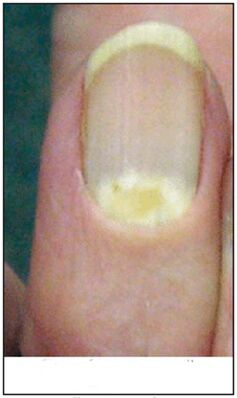
Proximal-deforming onychomycosis begins to develop in the case of a candidate nail lesion.The main characteristic of the disease is the nail bed.With this form of the disease, it deforms and becomes in the form of a wave.
Atrophic
Atrophic onychomycosis is characterized by a change in the color of the nail plate to a brownish gray.The nail is affected by the outer end and gradually moves to the skin roll.
There are such signs:
- Loss of the natural gloss of the nail.
- The plaque is atrophied.
- The nail bed is exposed.
- The nail is smoother and atrophy in the future.
- The nail bed has a layer of skin flakes.
- The infection is applied to adjacent tissues.
In atrophic onychomycosis, only the germination of the nail does not touch.
Methods of treatment
Before you begin treatment of any form of onychomycosis, you should contact a dermatologist for diagnosis.Only after laboratory tests and determination of the amount of the affected areas is prescribed additional treatment of the patient.
As a rule, in the treatment of onychomycosis, local medicines and medicines are used to take the penistle.
For more effective treatment, in addition to taking medication, it is recommended to treat personal objects and common subjects in order to exclude re -infection.
Perhaps treatment with the following ways:
- Physiotherapy.This procedure is prescribed to improve the circulation of the limbs.Physiotherapy is used in combination with UHF and amplipuli-carration in lumbosacral and cervical departments.Laser therapy and diathermia are also used.
- In the event of a neglected disease, when the nail is deformed and exfoliated, doctors decide to remove the nails.This will further prevent the fungus from spreading and will give medicines more efficiently working on a healthy surface.
Pharmacy
The main methods of combating fungal diseases include antifungals.They cause more damage to the nail sponge and therefore effectively treat the affected areas.Antifungals are suitable for the treatment of almost all types of diseases, except for the candidate (here treatment should be selected individually).
Dermatologists often prescribe the following antifungals:
- Varnishes that can protect the nail from the more increasing development of the disease.
- Solutions that destroy the nail roller fungus and the dish itself.
- Ointments or gels that relieve itching and inflammation.
When local treatment does not give the right effect to the end, preparations are prescribed for intake inside.The main difficulty of treating such agents lies in a large number of contraindications and precautions.The effect of the drugs increases gradually.
Traditional medicine
Folk medicine can be used in the treatment of fungal disease, but only in connection with other medicines.
Tea sponge
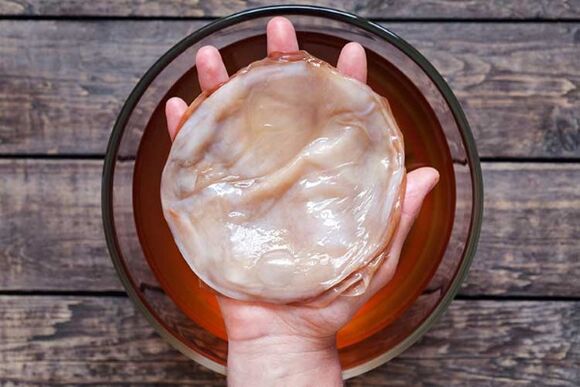
To use it, you need to stew your feet.Then apply a small piece of sponge to the diseased nail, bent with a bandage.The compress is kept overnight and removed in the morning.Deleted dead areas must be removed and then treat the surface with any antiseptics.The course of treatment lasts for several weeks.
Air
The decoction of Kalamus is also able to become an assistant in the fight against nail fungus.Take such a decoction 3 times a day.During administration, it is necessary to cut the crushed skin and growing nails.
- To prepare the product, 2 tsp.Grind the rhizomes of the plant and pour boiling water (as a rule, 100 ml is sufficient).
- The rhizomes are then boiled in water for no more than 1 minute.
- When the product cools, it is ready for use.
Due to the fact that the decoction has a bitter taste, it can be washed with water.
Vinegar
Sidish baths have good effect only in the initial stages of the disease.In the future, they are only used with the doctor's permission and with other medicines.
Sidy baths soften the epidermis, improves blood circulation, and also transforms the appearance of the legs.
Vinegar can be used in combination with the following components:
- Soda.It noticeably softens the epidermis and improves the effect of the procedure as a whole.In order to prepare the solution for the procedure, it is necessary to stir 0.5 tbsp.vinegar with 2 tbsp L. L.Soda.
- Essential oils.Such a component reduces the course of treatment several times.3 drops of oil are required for one bathroom with vinegar.
- Glycerol.For 3 liters of water, 9 tbsp.l.vinegar and 3 tbsp.l.Glycerol.When preparing the solution, glycerin is added to the water for better dilution.Glycerin in vinegar baths helps to moisturize the skin of the feet.
Baths can also be used as a prevention.
There are a number of contraindications in which vinegar baths cannot be used:
- Oncology.
- Wounds, ulcers and scratches on the legs.
- Individual intolerance.
- Thrombophlebitis.
- Pregnancy.
- Disorders of the cardiovascular system.
- Age of 10 years.
Before the procedure you have to take 3 steps:
- Take a sensitivity test.A small area near the elbow is moistened with a prepared solution.After 15 minutes.There should be no allergic reactions (itching, burning, redness).
- The legs must be stewed before the procedure and the affected tissues are removed.
- After the procedure, you should rinse your feet and dry well.You cannot load your legs for 2 hours.
- The duration of the procedure is 10-20 minutes.
In general, treatment with vinegar baths lasts 2-3 weeks.
Tea tree
The use of tea tree oil contributes to the effective restoration of the affected nail.During the procedure, oil under the nail should be applied when calculating 1 drop per 1 nail.The procedure is performed 3 times a day.The treated nail areas should be glued with a patch so that the effect of treatment will be higher.
Iodine processing
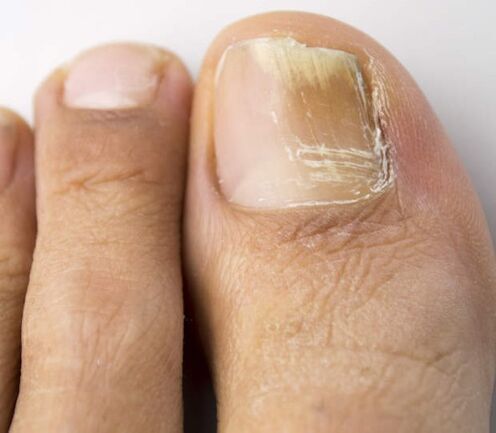
In the fight against nail fungus, iodine is widely used.It is best to use a 5% solution for the procedure.All that is needed for treatment is to apply iodine solution twice a day to the affected area of the nail.
When applying iodine, a feeling of burning is possible.If the burning sensation is weak and does not cause discomfort - everything is fine.If the pain is severe, then iodine treatment should be stopped immediately.The course of treatment with iodine solution is 2-3 months long.
The sophisticated stage of the disease can have more serious consequences.Whatever independent treatment the patient does, at the first signs you need to consult a specialist.By the way, the nail fungus looks, the doctor will be able to prescribe full treatment.Onychomycosis of the legs is treated fairly and effectively with the right approach.
















